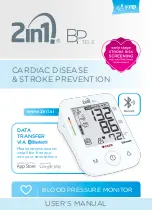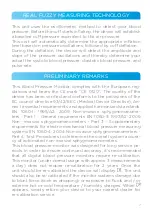
4
diagnosis. Thus PARR is not meant to replace any medical
ECG diagnosis by your doctor. PARR provides an early
detection of certain pulse arrhythmia, which inevitably need
to be presented to your doctor in charge.
Remark: [1] Clinical Investigation of PARR - A new
Oscillometric Pulse Arrhythmia Type Discriminating
Detection Technology.
The upper chambers of the heart (the atria) do not contract,
but quiver and thus blood is driven irregularly and with lower
efficiency into the ventricles. Subsequently irregular heartbeats
occurs, which mostly are associated with a fast, yet highly insta-
ble heart rate. This condition is associated with a higher risk for
the formation of cardiac blood clots.
Amongst others, they may elevate the risk of brain strokes.
Beside this atria fibrillation may contribute to the severity of a
chronic or acute heart failure condition and may be associated
with other heart-related complications. Age dependent, about
10% - 20% percent of patients suffer from an ischemic stroke
also suffer from atrial fibrillation. Atrial fibrillation most often
initially occurs with temporary periods of arrhythmia and may
progress to a permanent state of this disorder in the course of
time. No matter, whether you intent to safeguard yourself from
an undetected AFib state, or you measure during an ongoing
period of active atrial fibrillation, or you measure in between
periods of AFib, the PARR technology can be applied at any
of these conditions. This unit is able to detect Atrial fibrillation
(AFib). The ARR and AFib icons (
) are displayed right after
the measurement if Atrial Fibrillation was detected.
Note: It is strongly recommended, that you consult your phy-
sician, if either the AFib icon occurs newly for several times,
or, if your AFib is known to your doctor, but the incidence of
AFib readings changes over time. your doctor will then be
able to provide all required medical test and possible thera-
peutic procedures.
ATRIAL FIBRILLATION DETECTION (AFIB)





































